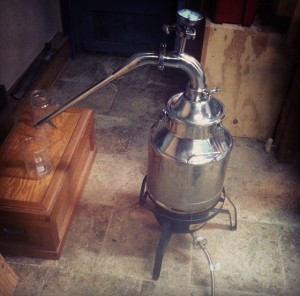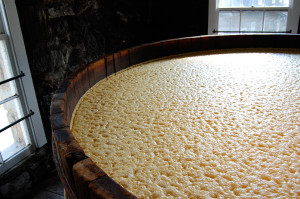The most important thing to know about distilling is safety. First and foremost, you should not drink any alcohol while your still is running. Also, alcohol is highly flammable, so treat it as such. There is a common myth that stills will blow up. This is mostly a myth, but it’s still possible. The biggest cause of this is having a condenser that is too small. If there isn’t any way for the steam to escape pressure will begin to build up and cause your still to blow out. This is an incredibly rare occurrence that most often happens with poorly home produced still.
Another important thing to note is that distilling can take hours, and you don’t want to leave your still unattended. Distilling can take anywhere from 3 to 9 hours depending on the size of your still. You will need to have few distractions during this time.
During Prohibition there was a large scare that the moonshine being produced was toxic and cause some people to go blind. Perhaps the biggest cause of this during the prohibition years was the U.S. Government. The reason for this was that the government purposefully poised alcohol in an attempt to prevent people from consuming alcohol. Many  moonshiners during this time would use industrial alcohol in their manufacturing process. The government caught onto this and required many manufacturers to add ethanol and even mercury to their product.
moonshiners during this time would use industrial alcohol in their manufacturing process. The government caught onto this and required many manufacturers to add ethanol and even mercury to their product.
One reason that people should shy away from consuming other peoples moonshine is that you don’t know how it was made. Some unscrupulous producers use lead to make their stills. This of course can cause lead poisoning. They may also cut their product with nasty chemicals. As such, you should be wary of any illegally produce liquor if you don’t how or who produced it.
There are many steps involved with distilling. A brief overview of the process is as follows:
The first thing you will want to do is find a recipe that you will want to try out. Usually this will include some combination of grain such as wheat, barley, rye, and corn. Many people involved in making moonshine will also add cane sugar in order to up the alcohol content. Your local home brew supply shop can be a great recourse for grains such as malted barley. See recipes for more information.
After you assemble the grains you will be using, you will want to put them into you fermentation tank. You will then heat a large kettle (30 liters or more) until it comes to a light boil. After your kettle comes to a light boil you will want to poor it into you fermentation tank and stir. Many people will heat the gain in the kettle. One problem with this is that the gain (especially corn) will sink to the bottom of the kettle. If you don’t continuously stir your kettle the corn will sink to the bottom and burn.
After 20- 30 minutes you can add cold water and cool it down to room temperature. You can then add and stir in your Cain sugar. At this point you will have what is called wash (or mash). Basically anything that has a significant amount of sugar added is a “wash.” You will want to make sure that your wash is well oxygenated. A good stirring should be all you need to get it oxygenated.
Once your wash has cooled down to room temperature you are ready to pitch your yeast. Many people like to use Turbo yeast. However, many people hate Turbo yeast with a fiery passion. Turbo yeast is decent yeast if you want to make a neutral spirit. However, you will want to use something like whiskey that has more flavor. One of the most popular yeast strains is known as “Prestige,” which is made in Sweden. You can also use wine or beer yeast.
The fermentation process involved in making moonshine is the same as with making beer. Your wash or “mash” can
take anywhere from 4-8 days to ferment. Your mash should start foaming and producing foam and bubbles within a couple hours. If you don’t see any signs of fermentation within the first 12 hours you have a problem. This could most likely be due to either not having enough sugar, or the temperature is either to hot or too cold.
After your mash is done fermenting you will be ready to make your first run. If you are using a pot still (the most commonly used) you will need to do two runs. The first run is called the “beer stripping run.” After your first run you will have what is called low wine. Low wine will be around 40-30% alcohol. Check the alcohol content with an alcohol hydrometer until the alcohol content drops below 20%.
You will have to do several beer striping runs until you have enough “low wine” to do your final run. You final run is called the “spirit run.” The spirit run is where you will make your cuts and decide what to keep and what to re-distill with your next batch of low wine.
If you are using a 5 gallon still, you will have to do around 4-5 beer striping runs until you have enough to do your spirit run. Unless you are using a larger still for your beer striping run and a smaller still for your spirit run. However, you can also add the heads and tails from previous spirit run. If you choose to do this (most do) you may find it advantageous to water your low wine down to 40 percent.
When you do your spirit run you will want to make your cuts. Making cuts refers to deciding what you will want to keep what you will want to redistill. Making good cuts is an important aspect of distilling. As such, it deserves its own article. Please see the article on making cuts.
After you make your cuts, you will know have moonshine. If you decide to age your spirits you will want to use an alcohol hydrometer and cut your moonshine down to 50-60 percent for aging. Especially if you are using an oak barrel.
I hope you find this guide useful and don’t hesitate to ask any questions that you may have.


When you start getting your first bit of shine i have been reading to throw the first part out. Is that methanol? and does it really cause blindness like i have read?
Yes it can cause blindness. No you don’t have to worry. All distilled spirits have some traces of methanol. However, most of the methanol is concentrated at the beginning of the run (the first to come out). That is why you throw out the first 150ml or so. Most of the stories of people going blind comes out of prohibition. The reason for this was that some moonshiners would use industrial alcohol to cut their product and up the alcohol content. The government got wise to this and unwisely decided to require all industrial alcohol to contain methanol. The idea was that it would scare people away from consuming alcohol.
As previously stated, all distilled spirits have some methanol. However, you would have to drink a lot of it before going blind. So much, that you would be at a larger risk of alcohol poisoning. You will be fine as long as you throw out the first little bit. Home distilling is legal in many countries such as New Zealand, and they haven’t had any issues with people going blind.
A new topic… I am having problems fermenting… My sugar shine works beautifully but I have tried 2 grain mashes with no sugar and have had little success… Maybe 12 hrs of a good roll then nothing… I tried to run one of them today and my first jar (after 1.5 hrs) was about 95 proof and now its at 205 degrees and getting about 1 drip a second… I used #2 malted barley at 150 degrees for 90 mins.. Cooled and pitched yeast….The beer smelled good but the shine is $shit.. Any Ideas??
How much whiskey did you get before it dropped down bellow 65%. How much did you distill?
How much spirit should you get out of 5 gallons mash.? Thanks
You will get close to a gallon of “low wine.” You will need to save u your low wine over several runs (about 5) before you have enough to do your “spirit run.” You will get about three quarters of a gallon of drinkable spirits depending on how picky you are and how much you dilute it for drinking. It also depends on the alcohol content of your mash.